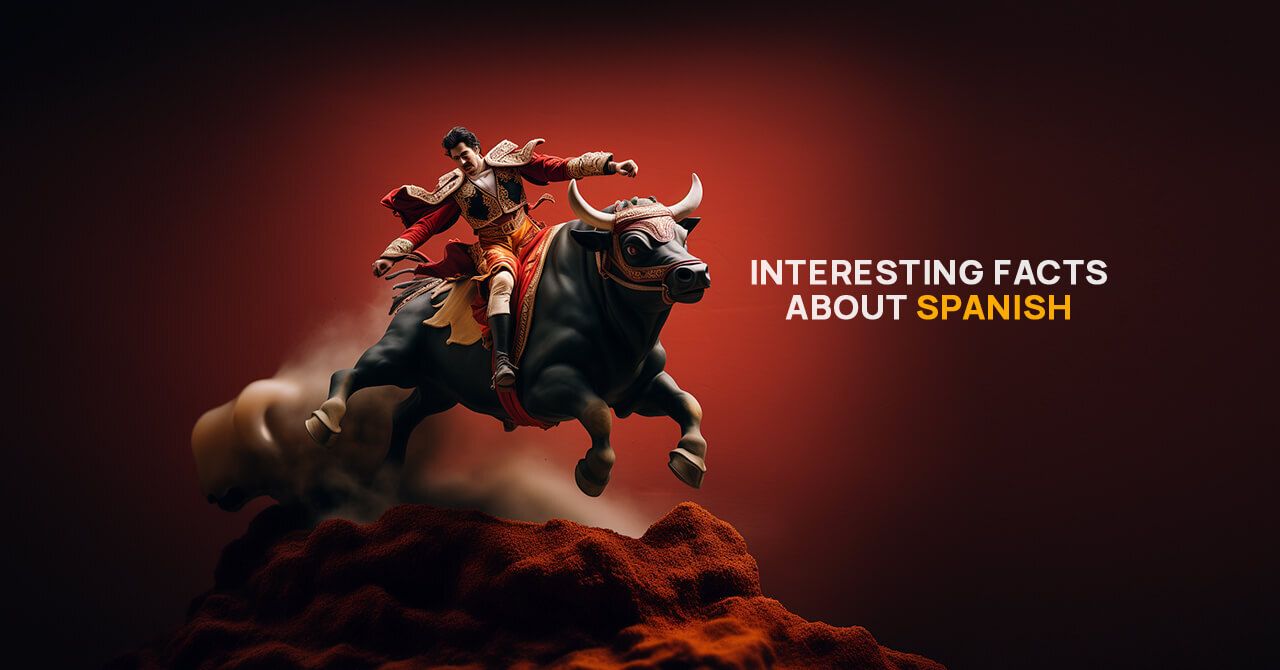
16 Fun Facts About Spanish that You Might Not Know
Not only is it an interesting language to learn, but it also has the potential to open doors to opportunities worldwide due to its extensive global reach.
If you’re here, then you no doubt want to learn something new and interesting about the beautiful Spanish language, so let’s dive right in...
Spanish facts about its origins
Spanish has two names
The language comes from the Kingdom of Castile in central Spain. For this reason, it is also called “Castilian.”
In Spain, both “español” and “castellano” are frequently used, with the former being employed more often internationally to refer to Spanish in general, irrespective of regional variations. In Spain, particularly in regions where other languages or dialects coexist alongside Spanish, such as Catalan or Basque, “castellano” may be used to distinguish it from those regional languages.
It comes from Latin
During the Roman Empire, Latin was spoken on the Iberian Peninsula. Over time, it developed into several Romance languages. In the northern part of the peninsula, this gave rise to “Castilian,” the Spanish we know today.
When the Moors, who were Muslims from North Africa, conquered much of Spain in the early 8th century, Arabic influences began to affect Spanish words.
Over hundreds of years, Spanish continued to change, picking up words from Arabic and various Romance languages, in addition to the indigenous languages of the Americas after colonization.
Facts about the Spanish language
There are over 500 million speakers
In 2023, there were more than 486 million people across the globe who spoke Spanish as their mother tongue. This number has undoubtedly increased since then. It is, therefore, the second most spoken native language, after Mandarin.
Furthermore, there are over 100,000,000 non-native speakers, bringing the total number of Hispanophones to close to 600 million. That makes it the fourth most used language in the entire world.
It’s an official language in 20 countries
Spanish is an official language in 20 countries, as well as Puerto Rico, a territory of the United States of America. Mexico has the most Hispanophones by far, with upwards of 130 million citizens.
It’s a widely spoken unofficial language, too
You may be surprised to discover that Spanish isn’t the official language of Andorra, Belize, or Gibraltar, in spite of the huge number of Hispanophones residing there. Gibraltar and Andorra share borders with Spain, while Belize is bordered by Mexico and Guatemala. This explains why Spanish is commonly spoken, not only among citizens but in some official contexts too.
The US has more Spanish speakers than Spain
Another fun fact is that the USA has over 60 million Hispanophones, more than the total number of people in Spain itself, which is around 48,000,000.

Spanish language facts
Spanish words can be really long
The longest Spanish word, with a whopping 24 letters, is electroencefalografistas. It means “electroencephalographers,” who are specialists in the brain measurement technology of electroencephalography (EEG). Another crazily long word, with 23 letters, is anticonstitucionalmente, which means “unconstitutionally.”
The grammar is similar to French and Italian
Spanish has some particularities when it comes to grammar, many of which are shared with other Romance languages, including French and Italian.
- Verbs change their endings to match the subject, whereas English verbs usually only change for third-person singular subjects.
- Spanish often forgoes subject pronouns (yo, tú, él, ella, nosotros, vosotros, ellos, ellas) due to the verb conjugations indicating the subject.
- Spanish has an extensive system of tenses and moods, including various past tenses, the subjunctive mood, and more.
Spanish has gendered nouns
Spanish nouns have a gender. This means that they are either masculine or feminine. One way to remember the gender is that words ending in O, R, L, or Y are usually masculine. Spanish has definite articles, el, la, los, las, and indefinite articles, un, una, unos, unas, which must agree in gender and number with the noun they modify, for example:
- Un león (a lion) → una leona (a lioness)
- Un amigo (a male friend) → una amiga (a female friend)
Adjective endings also change depending on the noun’s gender and number, for example:
- El coche rojo - The red car (masculine, singular)
- Los aviones rojos - The red airplanes (masculine, plural)
- La mesa roja - The red table (feminine, singular)
- Las sillas rojas - The red chairs (feminine, plural)
Spanish uses inverted punctuation
The primary difference between English and Spanish punctuation is the use of inverted question marks (¿) and exclamation marks (¡) at the beginning of a sentence to indicate a question or exclamation. Interestingly, it is the only language to do so. For example:
¿Te gusta el queso?
¿Estás de broma? ¡Me encanta el queso!
Translation:
Do you like cheese?
Are you kidding? I love cheese!
While we’re on the topic of punctuation, Spanish typically uses guillemets as quotation marks (« »).
Spanish uses accents
The accents á, é, í, ó, ú are used to show stress and changes in pronunciation. Accents can even change the meaning of a word. Here are a few examples:
- Sí means “yes.”
- Si means “if.”
- Él means “he.”
- El means “the.”
- Papá means dad
- Papa means potato or Pope.
- Sé means “I know” or “you know.”
- Se is a reflexive pronoun or part of other verb forms.
Accents can also be used to change the tense of a verb:
- Depósito means “a deposit” or “a warehouse.”
- Depositó means “he/she deposited,” the past tense form of the verb depositar.
Other languages use many Spanish words
As languages evolve, words spread from one language to another. The increase in international travel over the last couple of decades has escalated this further.
It can happen when one language doesn’t have a specific term for something, so they borrow it from another language. Other times, it happens naturally through conversations among speakers of different languages who start to use each other’s vocabulary.
There are many words that are used in English as well as in some other languages that are taken from Spanish. For example: Cafeteria, Iguana, Macho, Plaza, Poncho, and Ranch.
There are also English words that come from Spanish but have changed along the way:
- Breeze, from brisa, meaning a cold, northeast wind.
- Canyon, from cañón.
- Cargo is from the verb cargar meaning “to load.”
- Cockroach, from Spanish cucaracha, you’re no doubt familiar with the song of the same name.
- Hurricane, from Spanish huracán.
- Tornado, from Spanish tronada.
- Vanilla, from Spanish vainilla.
- Vigilante, from Spanish vigilante, meaning “watchman.”
Hispanophones roll their Rs
Generally speaking, Spanish pronunciation is pretty straightforward. The vowels each make just one sound, and there are very few silent letters, making it easy to read words as they are written.
The main difficulty for learners of the language is the rolling of the “r” sound. This is called a trill, and it’s made by vibrating the tip of the tongue against the ridge just behind the upper front teeth.
The trilled “r” sound is used in specific circumstances, for example, when the letter “r” appears at the beginning of a word or after certain consonants. One of the most well-known examples is the double “r,” which has a distinct pronunciation, such as in perro.
Some words contain all 5 vowels
In many languages, it’s extremely rare to come across a word containing all five vowels: A E I O, and U. In Spanish, however, this is far less unusual. These words have a name: pentavocálicas, from the words penta, meaning five, and vocálicas, meaning vowels. Some examples include abuelito (grandpa), comunidades (communities), and orquídea (orchid).
We use a lot of Spanish food words
Spanish culinary terminology is prevalent around the world. Spanish explorers and settlers introduced ingredients and cooking methods during exploration and colonization, particularly impacting Latin America and the United States. The rich and varied Spanish cuisine spread thanks to trade and cultural exchange, making Spanish food names known worldwide. The migration of Spanish-speaking communities helped to further spread these terms, notably in regions with significant Hispanic populations.
Well-known Spanish food names:
- Burrito
- Taco
- Nacho
- Chorizo
- Churro
- Quesadilla
- Jalapeño
- Salsa
- Tortillas
- Papaya
Spanish drinks:
- Daiquiri
- Mojito
- Tequila
- Piña colada
Interesting facts about Spanish
Spanish speaking celebrities
Aside from famous Latino stars, there are plenty of other celebrities that have learned Spanish.
Will Ferrell speaks Spanish very well, as showcased in the film Casa de Mi Padre. What’s shocking is that he only had a high school level before making the movie, but he decided to commit to learning so as not to disrespect the Hispanic audience.
Matthew McConaughey learned Spanish when he lived in Uvalde, Texas, just 80 miles from the Mexican border. Learning the language enabled him to converse more easily with friends and locals.
Singer Michael Bublé felt obliged to learn Spanish in order to communicate more easily with his wife, Luisana Lopilato, who is Argentinian.
Acting brothers Ben and Casey Affleck both speak Spanish and not because of Ben’s relationship with Jennifer Lopez, one of North America’s most famous Latinas. In fact, they learned the language as teenagers living in Mexico.
Grey’s Anatomy and Killing Eve star Sandra Oh is another famous Spanish speaker. As a matter of fact, she’s a talented polyglot, speaking several languages fluently.
Want to be among cool Spanish speakers? Start learning Spanish today on LiveXP and become a confident speaker in no time!
Spanish is one of the most increasingly spoken languages for several reasons. It has a melodic sound, straightforward pronunciation and boasts a rich history deeply rooted in culture, and has spread to many parts of the world. Not only is it an interesting language to learn, but it also has the potential to open doors to opportunities worldwide due to its extensive global reach.
Hello! My name is Beth. I'm from France. I'm a French and English native speaker and I really like writing.

